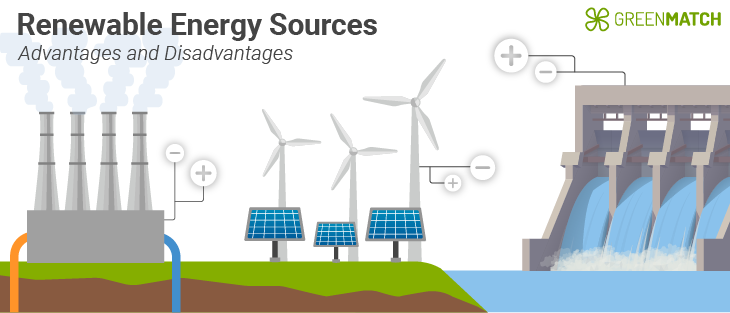What Exactly Is Renewable Energy?
Renewable energy is any form of energy available in the natural environment and can be replenished repeatedly. For example, solar energy is naturally available, and we can’t run out of it by consuming it.
On the contrary, as we’re burning fossil fuels like oil and coal, their resources constantly decrease. Scientists have estimated that the total remaining oil resources might last around 190 years. This estimation is up to 230 years for natural gas resources.
Unfortunately, renewable energy is supplying less than 16% of the total energy that we’re currently consuming in the world. However, this share is constantly increasing, especially in advanced countries that have supportive policies. For instance, the UK has planned to increase its renewable capacity from 47.16 GW in 2019 to 86.21 GW by 2026.
7 Types of Renewable Energy Sources
Fortunately, renewable energy is available in various forms depending on the location and the season. For example, some areas have gale-force winds, but the sunlight is not enough because of cloudy weather.
Having a distributed network from different forms of energy can ensure that we have sustainable and clean energy. Here are 7 types of alternative energy sources available out there:
Solar Energy
The only type of renewable energy that you can easily harness at your home is solar energy. You just need to buy either solar water heaters or solar panels to use solar energy and reduce your energy bills. There are different types of PV panels and you can choose the best one for your home according to the price, efficiency, and some other criteria.
Wind Energy
To utilize gale-force winds, we need to build large turbines in windy areas. Wind farms can help rural and remote areas to have green electricity. For example, offshore and onshore wind in the UK is generating around 24.2% of the UK’s electricity.
Hydroelectric
Hydroelectric power is somehow similar to wind energy technology except for the working liquid, which is water instead of air. Building large dams and using turbines might be expensive, but it will produce a great amount of electricity.
Geothermal Energy
Geothermal energy is another clean and renewable energy that can be regarded as a sustainable source of power. It is the heat within the planet earth that can be harnessed in some areas.
Biomass
Biomass energy is the heat we can derive from organic waste by burning them. It’s regarded as a renewable energy source because we always regenerate organic materials, mostly plants.
Tidal Energy
Tidal energy, also known as ocean energy, is the hydropower energy we can get from tides. This energy is sometimes sorted under the category of hydropower, not in a separate one.
Hydrogen
Hydrogen is the most abundant element available on our planet, two-thirds of which in the form of water. If we can separate this element, it can be used as a zero-carbon fuel.
Advantages of Renewable Energy
First, it’s good to look at the advantages of using renewable energy sources instead of burning fossil fuels. Here are several important benefits of using renewable energy:
1. Renewable Energy Sources Will Not Run Out
As it comes from the name, a renewable energy source is sustainable, meaning that it will not run out soon. For example, the sun is expected to shine every morning for at least 4.5 – 5.5 billion years to come, so we can consider it a renewable source of energy. This might be the most important difference between renewables and fossil fuels.
2. Renewable Energy Is Reliable
Despite fossil fuels that are always subject to disputes and wars between countries, we can easily and peacefully gain control of renewable energy sources.
In other words, trade laws, political instabilities, territorial claims, and markets’ turmoil cannot impact the use of renewable energy sources.
Although renewable energy sources are not distributed equally, with a smart and widespread energy network, it’s possible to use them as reliable means of supplying energy.
3. Renewable Energy Is Environmentally Friendly
Renewable energy sources are natural ways of energy generation, and therefore, can be considered clean. Although renewable energy technologies can cause some emissions, overall, minimum carbon and GHG will be emitted to the environment when using them.
When you compare them with fossil fuels, the difference is significant. Therefore, catastrophic environmental issues like global warming, climate change, and low air quality can be omitted if we go for renewable energy.
4. Renewable Energy Can Increase Public Health
By reducing greenhouse emissions and other polluting substances, we’ll have healthier air and soil. This will definitely improve public health, and subsequently, people we’ll have happier lives. Additionally, having a healthier population will cause a significant reduction in the health budget people and governments should set aside each year.
Scientists have tried to improve fossil fuel technologies to make them less polluting without reducing the efficiency. However, renewable energy technologies are still way healthier than traditional technologies.
5. Renewable Technologies Create Lots of Jobs
Apart from the environmental impact of using renewable technologies, they can have some beneficial influence on the economy. This is especially important in some unprivileged regions. In fact, this is a new and stable job market that has recently emerged and can empower people in poor areas.
With a concerted effort and prudent investment, renewable jobs can reduce poverty all over the globe. Also, it can prevent people from emigrating from the countryside to urban areas. Governments can offer them a fair share for generating renewable electricity in their farms. In advanced countries such as the UK, numerous renewable jobs have already been created in the wake of governmental grants.
6. Renewable Technologies Require Less Maintenance Cost
If you look at renewable energy technologies and compare them with fossil fuels’ power stations, you see less moving or combusting parts. Although you can see turbines in wind farms or hydropower stations, solar energy systems don’t need any rotating parts. This makes renewable energy technologies more durable, and therefore, you will spend less money on maintenance and repair. Overall, the operational cost of renewable energy stations is significantly less than what we see in traditional power stations.
7. Renewable Energy Can Reduce Turmoil in Energy Prices
If you usually follow the news, you must have heard of daily ups and downs in the oil prices. Renewable energy can be of great help in this regard and reduce these turmoil and make the global energy market more stable. Because using renewable energy only demands an initial investment, and you don’t need any fuels.
On the contrary, using traditional technologies demands a significant budget for fossil fuels prices, which is subject to ever-existing inflations. When countries reduce their reliance on fossil fuels, the prices in this market will change more smoothly.
8. Renewable Energy Can Increase Countries’ Economic Independence
With a distributed network of renewable energy technologies, countries with no fossil fuel resources can reduce their energy dependence. In fact, local people can generate electricity using renewable technologies and help governments reduce oil imports. This will decrease the risk of energy crisis and has a beneficial influence on the countries’ sustainable development.
9. Leftovers Can Be Used in Renewable Technologies
Landfills are among the major crises in the world. It’s good to know that some sorts of renewable energy technologies can use leftovers and reduce the amount of and waste materials that are piled in landfills.
Biomass energy, for instance biomass boilers, has this beneficial aspect that can consume used organic products as fuel. This is a promising way that lets us kill two birds with a single stone.
First, reducing the size of landfills, and second, generating energy without paying for fossil fuels.
Disadvantages of Renewable Energy
Now, it’s time to look at some disadvantages of renewable energy that make using them difficult.
1. Renewable Energy Is Not Available Round the Clock
Renewable energy sources are natural forces that are strongly dependent on the weather condition. Therefore, when you have bad weather conditions, renewable energy technologies such as solar cells will be of less use.
For example, when it rains, your PV panels can’t generate electricity, and as a result, you have to get back to traditional power sources. We can consider this uncertainty the most important drawback of relying on renewable technologies.
2. The Efficiency of Renewable Technologies Is Low
Each type of energy requires a specific technology so that we can convert it into electricity. The efficiency of energy conversion devices is of great importance when it comes to prioritizing energy sources. Unfortunately, the efficiency of renewable technologies is not that high compared with traditional energy conversion devices.
For example, solar panel efficiency, that are available in the market, is between 15% and 20%. On the other hand, traditional technologies that use coal or natural gas can respectively reach efficiency levels of up to 40% and 60%.
3. The Initial Cost of Renewable Energy Is High
Considering the amount of energy we can get from renewable technologies, their initial cost is high and sometimes unaffordable. In fact, the manufacturing and installation processes of renewable energy devices like PV panels are relatively expensive. That’s why governments are setting aside considerable budgets, such as solar panel grants to help these technologies grow.
4. Renewable Energy Sites Require A Lot of Space
To harness nature’s energies, we need a lot of space. This will cause many problems for renewable energy sites. In comparison with traditional power stations, we have to use more land for establishing renewable energy farms.
5. Renewable Energy Devices Need Recycling
Generating electricity from renewable energy sources produces way lower levels of pollution. But renewable devices are subject to some concerns because manufacturing them and also their disposal process might emit pollution.
For example, solar cells will fail to perform well after a while, so we need to throw them away. But these devices might be toxic, and as a result, we need to think of a recycling process for them.
Why is Renewable Energy Important?
We’re now facing unprecedented heatwaves, polluted air, and unbelievable health issues caused by fossil fuels. In Addition to this issue, fossil fuels are about to run out if we continue to burn them uncontrollably.
Renewable energy sources are our best chance to stop the current trend and make the world a better place to live. Therefore, governments are thinking of using renewable sources of energy to generate electric power. As a result, there is increasing usage of renewable energy for generating electricity in all countries.
For example, the share of renewable energy in global electricity generation was increased to 29% in 2020. This is a success compared with a 27% share in electricity generation in 2019.
Some advanced countries such as the UK have aimed for 100% renewable cities by 2050. Currently, around 43% of the UK’s electricity is generated by renewables. In spite of many obstacles in the way towards 100% renewable energy, there are promising advantages to using renewable technologies.
Overall, the advantages of using renewable energy sources outweigh the disadvantages. Although the initial cost of establishing a network of renewable technologies might be higher, over time, the expenses will be offset. Considering the lateral influencers of using renewable energy, postponing the process of shifting toward 100% renewable is not a wise course of action.
![]()
![]()
![]()



 We strive to connect our customers with the right product and supplier. Would you like to be part of GreenMatch?
We strive to connect our customers with the right product and supplier. Would you like to be part of GreenMatch?